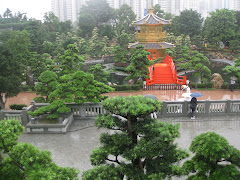Well, it is worth the hype. Machu Picchu is indeed absolutely stunning (thank you Kathy, Nat, Katie & Charis, Tom & Lisa, Bill & Alison, Shirley & Derek, Jack, Sue & Mike, Anne & Charlie, Marzena and Tim, Simon & Jane). I can see why the incas built their citadel surrounded by mountains, and I imagine it was a real wrench to leave when the Spanish invaded. I have an awful lot of photos below, but I will first give you a bit of a background on the incas. First of all, 'Inca' means king, and so there was only ever one Inca at a time. The rest of the population in the 1400s in South America were Quechuans. The inca trail spreads north and south from the citadel of Machu Picchu, where the Inca and his family lived, and covered all of the Quechuan empire. Messengers from the Inca would run this trail to collect taxes from the farthest reaches of the kingdom, and llamas would amble along it with panniers packed with potatoes (4000 varieties in Peru) for the royals. Along the trails there are terraces built into the hillside, which would be used to grow corn, potatoes and vegetables. The clever Quechuans even created microclimates within the terraces, with the thick stones in the lee of the wind retaining heat and keeping soil warm on the cold nights, whilst storehouses were slap bang in the wind, which made them natural fridges. You see these terraces across Peru, although they are not in use today.
 |
| Overlooking the sacred valley |
 |
| Nick overlooking the terraces |

We caught the train along the river Urubamba (which passes Machu Picchu and then feeds into the Amazon), and quite literally jumped off onto the train tracks about halfway along. There was about a metre drop between the (steep) train steps and the (uneven) ground, but luckily Nick and a train guard caught me as I flailed. We then joined the inca trail for a day's hike towards Machu Picchu. We weaved along the mountains, passing more terraces and climbing steeply. We actually didn't pass many people on the trail, which I found surprising. After lunch, Nick decided to run the last 6k and I met him at the sun gate, with a spectacular view of the citadel. On the 21st June (midsummer), the sun rises directly behind the sun gate, which funnels the light onto the altar in the church. This is a sign to the inca that the season is changing, from wet to dry, and the harvest will begin. The incas created many clever ways of harnessing the sun in religious ceremonies. They worshipped the mountains, the water and the sun, and most Peruvian men today wear a symbol to denote this. Our guide told us that although Peruvians will say that they are Catholic, and many attend church, in their hearts they worship the ancient inca gods.
 |
| Nick carrying my bag as well as his own when I got too out of breath |
 |
| Inca trail |
 |
| We met a llama on the terraces |

The relief at reaching the sun gate was palpable, and we gently descended into the citadel. We then took the bus down the hill to our hotel in Aguas calientes, a small town at the base of the mountain. We planned on visiting Machu Picchu properly the next day, when our clothes weren't sodden with sweat. Our hotel was upgraded as a honeymoon present from Chimu Travels, our travel agent, and boy it was fancy. It was just what we needed after a 18k hike, uphill, in the blazing sun. There was a sweet note from the hotel manager on the biggest bed I have ever seen in my life. It was about double the size of a normal bed, and so soft! I could lie sideways on it, and there was still space for Nick. We also had cocktails and a three course dinner included, which was divine. At the end of the meal the waiters also brought out a cake with toffee sauce writing proclaiming that we should have a happy honeymoon! I would highly recommend this hotel if anyone goes to Machu Picchu. It was the best nights sleep I have had in ages.

The next day, showered and well rested, we got up at 5.30am to catch the bus back up to Machu Picchu at 6.15am. Already there was a huge queue of tourists waiting for the bus. Whilst there is an official UNESCO sanctioned limit of 2500 visitors a day, our guide sadly told us that as many people as turn up are allowed in, as the Peruvian government cares more about the money than the upkeep. The citadel only housed between 500-600 people in the inca times, and there were more people than that there when we arrived at 6.30am! However, I can see why so many people visit; it is stunning and the history is highly interesting. The citadel is shaped like a condor, which can only be seen from above. The Quechuans liked to shape their cities like animals to please the gods; Ollayantambo is shaped like a llama and I think Cusco used to be shaped like a puma, before it grew. We spent a few hours wandering around and enjoying the views, before heading back down to Aguas Calientes and catching the train back to Cusco.
 |
| Machu Picchu |
 |
| Wayna Picchu (mountain), seen from the citadel |
 |
| Houses in the citadel |
















No comments:
Post a Comment